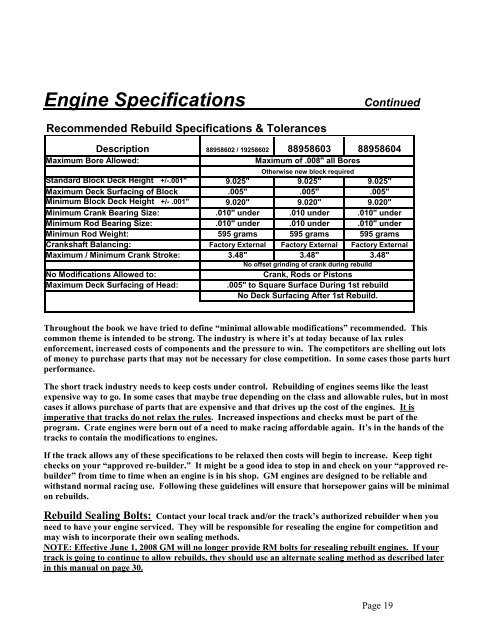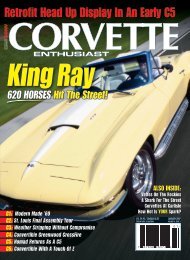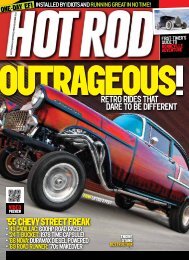Circle Track Crate Engine Technical Manual - Chevrolet Performance
Circle Track Crate Engine Technical Manual - Chevrolet Performance
Circle Track Crate Engine Technical Manual - Chevrolet Performance
You also want an ePaper? Increase the reach of your titles
YUMPU automatically turns print PDFs into web optimized ePapers that Google loves.
<strong>Engine</strong> Specifications Continued<br />
Recommended Rebuild Specifications & Tolerances<br />
Maximum Bore Allowed:<br />
Description 88958602 / 19258602 88958603 88958604<br />
Standard Block Deck Height +/-.001" 9.025"<br />
Otherwise new block required<br />
9.025" 9.025"<br />
Maximum Deck Surfacing of Block .005" .005" .005"<br />
Minimum Block Deck Height +/- .001" 9.020" 9.020" 9.020"<br />
Minimum Crank Bearing Size: .010" under .010 under .010" under<br />
Minimum Rod Bearing Size: .010" under .010 under .010" under<br />
Minimun Rod Weight: 595 grams 595 grams 595 grams<br />
Crankshaft Balancing: Factory External Factory External Factory External<br />
Maximum / Minimum Crank Stroke: 3.48" 3.48" 3.48"<br />
No offset grinding of crank during rebuild<br />
No Modifications Allowed to:<br />
Maximum Deck Surfacing of Head:<br />
Maximum of .008" all Bores<br />
Crank, Rods or Pistons<br />
.005" to Square Surface During 1st rebuild<br />
No Deck Surfacing After 1st Rebuild.<br />
Throughout the book we have tried to define “minimal allowable modifications” recommended. This<br />
common theme is intended to be strong. The industry is where it’s at today because of lax rules<br />
enforcement, increased costs of components and the pressure to win. The competitors are shelling out lots<br />
of money to purchase parts that may not be necessary for close competition. In some cases those parts hurt<br />
performance.<br />
The short track industry needs to keep costs under control. Rebuilding of engines seems like the least<br />
expensive way to go. In some cases that maybe true depending on the class and allowable rules, but in most<br />
cases it allows purchase of parts that are expensive and that drives up the cost of the engines. It is<br />
imperative that tracks do not relax the rules. Increased inspections and checks must be part of the<br />
program. <strong>Crate</strong> engines were born out of a need to make racing affordable again. It’s in the hands of the<br />
tracks to contain the modifications to engines.<br />
If the track allows any of these specifications to be relaxed then costs will begin to increase. Keep tight<br />
checks on your “approved re-builder.” It might be a good idea to stop in and check on your “approved rebuilder”<br />
from time to time when an engine is in his shop. GM engines are designed to be reliable and<br />
withstand normal racing use. Following these guidelines will ensure that horsepower gains will be minimal<br />
on rebuilds.<br />
Rebuild Sealing Bolts: Contact your local track and/or the track’s authorized rebuilder when you<br />
need to have your engine serviced. They will be responsible for resealing the engine for competition and<br />
may wish to incorporate their own sealing methods.<br />
NOTE: Effective June 1, 2008 GM will no longer provide RM bolts for resealing rebuilt engines. If your<br />
track is going to continue to allow rebuilds, they should use an alternate sealing method as described later<br />
in this manual on page 30.<br />
Page 19




